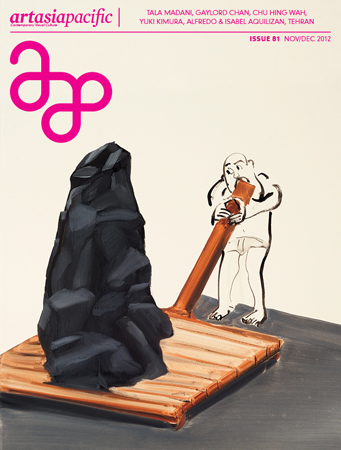Out Now
Novembers have a tendency to make us reflective. The most immediate topics to emerge from such ruminations might be: Who will soon be the new leaders of China and the next president of the United States? And what does that mean for the world, not to mention the contentious issue of the South China Sea?
However, more often than not, our reflections tend to dwell on matters more personal but no less significant. For the November/December issue of ArtAsiaPacific, we exchange notes with a number of artists, curators and cultural initiatives on the role of recent histories, both private and public, as a way of envisioning what the future might hold.
Our feature supplement “Expanding Asia,” produced in collaboration with Mathaf: Arab Museum of Modern Art in Doha and the Mori Art Museum in Tokyo, poses questions about the geographical construct of “Asia,” its origins and the many cross-cultural exchanges that take place there. We invited seven people actively involved in the art of the region—Deena Chalabi, Tsong-zung Chang, David Elliott, Nida Ghouse, Ranjit Hoskote, Vera Mey and Ashley Rawlings—to consider this new phase of Asian cosmopolitanism, which, as Hoskote and Chalabi remind readers, has numerous historical precedents.
Also looking at transnational exchanges—specifically those that occur with migration, whether voluntary or forced—is the work of Filipino husband-wife duo Alfredo and Isabel Aquilizan. Contributing editor Michael Young examines the peripatetic career of the Aquilizans and the way they collect and display the personal belongings of marginalized, itinerant communities to tell stories of the displaced and forgotten.
Tobias Berger, managing curator of M+, the future museum of visual culture in Hong Kong, sits down with Hong Kong’s celebrated artists Gaylord Chan and Chu Hing Wah. The two old friends recollect life during the nascent years of the Hong Kong art scene in the 1960s and ’70s, and discuss how distinct traditional cultures—such as Cantonese opera—might be revitalized by a transfusion of contemporary elements to help ensure that it remains significant for future generations.
Likewise observing ways that artists push new boundaries within an artistic practice, guest contributor Amelia Groom considers the work of photographer Yuki Kimura. She describes Kimura’s inquiry—involving the placement of objects relating to those she has captured on film, on top, below and beside the actual photograph—as “honing in on the instabilities of the photographic image and its ambiguous relationship with form.” Our cover feature by editor-at-large HG Masters delves into the work of three innovative young painters: Tala Madani, Rokni Haerizadeh and İnci Eviner. In his article, Masters argues that these three figurative painters, who address topics of violence, “offer inventive alternatives that the camera, for instance, plainly cannot.”
In Profiles, Manila desk editor Marlyne Sahakian talks with Filipino artist Carlos Celdran, whose performances and walking tours create more public awareness of Manila. Dubai desk editor Isabella E. Hughes meets Lantian Xie, the Chinese-born artist who grew up in Dubai and Bahrain, and whose migratory existence informs his poststudio mentality. On the eve of the seventh Asia Pacific Triennial, Michael Fitzgerald takes a detailed look at exhibiting artist Greg Semu’s photographic series that use postcolonial tropes to depict alternative narratives about the Pacific and the “Noble Savage.” And from Baku, Catherine Milner interviews 30-year-old Aida Mahmudova, founder of the nonprofit organization Yarat, which promotes awareness of Azerbaijan’s fledgling contemporary art scene.
Rounding out the issue, Brooklyn-based artist Seher Shah explains her admiration for the meticulous pencil drawings of Tedd Nash Pomaski. In Essays, Jyoti Dar comments on Indian performance artists’ ability to engage with diverse audiences. For The Point, we invite Indonesia’s Cemeti Art House founders, Mella Jaarsma and Nindityo Adipurnomo, to spell out the challenges of running a nonprofit alternative space in a market-obsessed environment, while art historian Helia Darabi files a Dispatch report from Tehran that reveals the dynamic and conflicted art scene in Iran.
Select articles now online in Arabic and Chinese: artasiapacific.com.
Subscribe, buy on Zinio, become a Facebook fan and follow us on Twitter.
